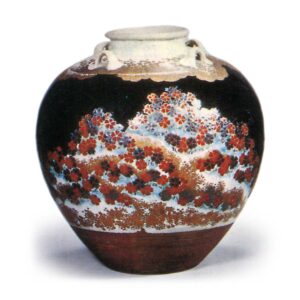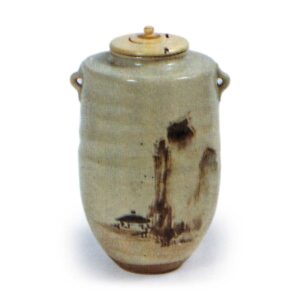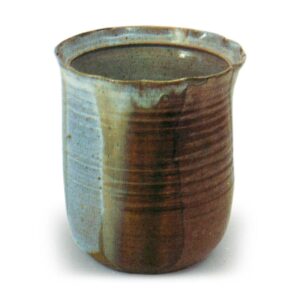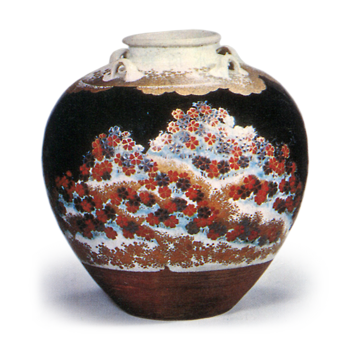


Master of Kyo-yaki pottery. He is famous as the founder of the purely Japanese taste in ceramics, and later developed his own unique lineage, called the Kyo-yaki lineage or the Ninsei lineage.
Biography: Born in Nonomura, Kitakuwata-gun, Tamba Province (Miyama-cho, Kitakuwata-gun, Kyoto Prefecture). The surname Nonomura is derived from this. The family name is also said to have been Fujiwara, as the earthenware sanguoku dedicated by Ninsei to Kitano Tenmangu Shrine in Kyoto is inscribed with the name “Nonomura Harima Taicho Fujiwara Masahiro (also known as Fujimasa) Ninkyo Irimichi”. The name “Ninsei” is a combination of the character “Nin” given by Ninna-ji Palace and his own name “Kiyoshi. Some say that his first name, Fujiwara Masahiro, was changed to Ninsei during the Shoho period (1644-8). Regarding Nikiyo’s teacher relationship, some say that he learned pottery from Matsukashi (Kuno Masahaku) when he was sent to Tosa (Kochi Prefecture) as a young man, while others say that Butsuami, a naturalized Korean in Tosa, was Nikiyo’s teacher. It is also said that he studied under Sohaku (Sohaku Sotani) at Seikanji Temple (Higashiyama-ku, Kyoto) and became a disciple of Sanjiya Kuemon of Awataguchi (Awataguchi, Kyoto), and that he received only the method of chajiru (tea-interleaving) from Takeya Genjuro. It is also said that the method of color brocade was invented in the Meireki era (1655-8) by Chawanuya Kyubei using the Hizen method, which he learned from Aoyama Koemon. There is no fixed theory as to the date of his birth or death, with some claiming that he was born in 1596, others that he died in 1660 at the age of 70, and still others that he died in 1666. Although the exact details of Ninsei’s biography are not known due to these various theories, (1) if Ninsei introduced Kakiemon’s color paintings during the Meireki era, the amount of his production was too large. (2) Legend has it that Ninsei was held by Kyogoku Takakazu of Marugame in Sanuki Province (Kagawa Prefecture) (the Kyogoku clan moved from Tatsuno in Harima Province (Hyogo Prefecture) to Marugame in January 1658) and fired pottery under the name of Takayo (born 1655~, Meireki era, died 1694, Genroku era, 7th year), Takakazu’s son. (3) The discovery of a Kaneko loan certificate (but a copy) with the inscription “December 29, 1674, Enpo 2-nen Tora (Tiger), Ninsei, Seiwemon, Seijiro” and “February 12, 1677, Nonomura Ninsei, Seiwemon,” (4) The discovery of a copy of “Morita Kyuemon’s Certificate of Loan of Kaneko” (but a copy).
(4) The article “I will visit Omuroyaki to see the pottery, there is no other ceremony, I will also visit the kettle place, the kettle is set, and I will bring the pottery to Izutsuya Han’emon” in “Morita Kyuemon Nikki”, August 20, 1678, indicates that Seiwemon is Ninsei, and (5) the article “Ninsei is a pottery master of Yamashiro Province (Kyoto Prefecture). (v) On the bottom of an incense burner donated by Ninsei to Anyoji Temple in Oharano, Nokun-gun, Yamashiro Province (Kyoto Prefecture), there is an inscription that reads, “In the third year of Meireki (1657), Harima Irimichi donated this incense burner to Ninsei Ugetsukidou,” and the accompanying note, “Record of Incense Burner Dedicated to Ninsei and Attached Certificate” written by the temple’s priest Jigen in March 1843 (Tempo-14) states that “This temple and this temple were established by this priest at a young age after his prayer for industrial advancement in the principal image was fulfilled. (viii) “The incense burner dedicated to Ninsei was dedicated to three places in Makio, this temple and the head temple, Omurogu Shrine, after he had prayed for industrial progress at the young age of this temple’s danna,” which indicates that 1657 was the time when he was most devoted to his work. (6) According to the diary of a Kaga domain retainer, when the Maeda family ordered tea utensils from Ninsei in 1693, Ninsei had already died and was in his second generation. Based on these several references, it would seem that Ninsei did not die at least in 1660 or 1666, but in fact lived until the beginning of the Genroku period (1688-1704). However, the grave site of Insei has not yet been discovered, and it is said that there were several generations of Insei, so it is very difficult to determine the exact period of his life. However, it is a fact without error that he lived around the time of Kanamori Sowa’s death (1656- Meireki 2, aged 73 or 85). This is because Nisei, like Rikyu in Chojiro, created uniquely beautiful ceramics under the guidance and assistance of Sowa. However, in the sixty-ninth issue of Chawan, Ninagawa Daiichi reported the following information about Ninsei from the “Goki,” a record of Ninna-ji transmission. In the Goki, an article dated July 19, 1650, “Tanbayaki Seiwemon came”; in an article dated September 26, Meireki 1, 1655, “In Niwajo Tsuboya Seiwemon no Yakimono Kata Shikakeme”; in an article dated March 10, Genroku 9, 1696, “Nonomura Seihachi himself requested that two people be provided for from now on,” and in an article dated Genroku 11, 1698, “Nonomura Seihachi himself requested that two people be provided for from now on. In the 11th year of the Genroku era (1698), the relationship between Ninsei and Ninnaji no Miya is clear in such passages as “Nonomura Seiwemon came this morning and returned late at night,” “Seiwemon came again today,” “Seiwemon the Pottery Master received ten pine trees,” and “Gomonzen Seiwemon Chikanai Pottery Preparation Report. Of particular note is the reference to Tanba-yaki Seiemon. The name of Nonomura Seihachi in the record, dated 9 Genroku, may indicate that he was the youngest son of Ninsei and succeeded him as the second generation. However, an article from around 1695 in “Sadachin’s Diary” in the Maeda Sonkei Kakubunko records that the 13 incense containers ordered from Ninsei were not well made. The “Goki” of Ninna-ji Temple is a record dating from 1649 (Keian 2), but the existing record lacks the middle part of the Enpo period (1673-81) and the Tenwa and Jokyo periods (1681-18). The Imperial Household at that time referred to Ninsei’s work as Gomonzen-yaki, but in the “Shinkei Iriomichi Shin’oki,” “Nijo Family Documents,” and “Keiki,” it is referred to as Omuro-yaki or Ninnaji-yaki. Munewa also wrote “Omuro ‘yaki'” in a box. There are as many as fifteen places reported as the kiln sites of Ninsei, including Gobosatsu (Fukamori), Seikanji, Komatsudani, Shibuya, Shimizu, Otowayamashita, Awata-Nikkozan Iwakurayama, Takagamine, Omuro, Ouchiyama, Narutaki, Akashiji in Harima (Hyogo Prefecture) and Marugame in Sanuki (Kagawa Prefecture), but the most reliable is Omuro (Kaei Nenma, 184854, Eiraku Kazen The most reliable is the Omuro Kiln (Eiraku Kazen also built a kiln in this former location in 1848).
The reason why Insei has long been respected is that his work, unlike that of other potters of the past, was purely Japanese in style, going one step beyond Chinese and Korean imitations, and his elegant and beautiful style truly marked a period in Japanese ceramic history. In other words, the potter’s wheel was extremely sophisticated, the curved surfaces raised like paper were extremely graceful, the painting was elegant and elegant, the color schemes were gorgeous, the brush strokes were soft, and the spatula marks were light, and all of the designs were original and ingenious. The base material of Inkiyo’s color paintings is generally divided into two types: one is a bluish light rat color glaze over unglazed ware, and the other is a slightly brownish glaze over glazed ware. The other has a slightly brownish glaze. On top of the glaze, bright and glittering color paintings are applied, and all of them have a series of sen nuki, which are called nikiyo no cones. In addition, except for celadon and underglaze blue, almost all of his works are from Japan and Korea, including Seto copy, Takatori copy, Shigaraki style, Mishima, Hakeme, Gohon, etc. His works include tea containers, flower vases, tea bowls, water jars, incense bowls, and mukozuke (a type of bowl with a small bowl for incense). Some of Ninsei’s pattern paintings are said to have Kano school brush strokes and Tosa style paintings. However, it is possible to imagine that he was not necessarily bound by the Kano school, but was greatly influenced by maki-e, pictures of wooden vessels of the time, and Momoyama-era paintings, and also accepted the tastes of Sowa and others. The thickness of the base of tea bowls and other vessels is almost the same as the thickness of the bowl itself, and the seal is stamped on the left side of the back of the bowl, on the lower left side of the base, or in the center of the bottom. This is one of the characteristics of his style. The glaze of the tea caddy is a brownish-brown color with a calmness characteristic of Insei, and the clay is clean and the thread cutting is superb. The clay is clean and the thread cutting is superb. Tea caddies, especially those with a shoulder impulse, are generally based on Chinese tea caddies, but they are slender and taller than most. (2) Some of the water jars are similar to the glazed tea caddies mentioned above, while others are painted in colors, and many of the painted ones, along with tea urns, are very glamorous. (3) Most of the tea bowls are of the Kureki style, with a few having a warped edge, but compared to Korai tea bowls, the shape of the bowls is tighter and the body is wider than the body.
The shape of the bowls is tighter than that of Koryo tea bowls, and the curve from the body to the waist is very tasteful.
The overall shape was thinly made with great dexterity, and many of those that remain today are painted with colors. The coloring is austere and stylish. (4) Except for Nikiyo Shigaraki tea pots made of Shigaraki clay, most of them are painted in colors. Many of the later types after Manji (1658-161) were thinly made, and unlike true jars and Song dynasty jars, the height of these jars is relatively low and the body is round and graceful. The paintings on these vessels are also extremely gorgeous.
The shape of the vase differs from that of the Song dynasty vessels in that it is shorter, and the body is rounder and more rounded, and the coloring is more gorgeous. There are many types, and those with the name “Qing” in a square shape are said to have been used before the name “Inqing” was used. Of those with “Insei” in an oval, the smaller ones are called koin (small seal).
There are also two types of seals, large and small, that do not have an outline. There are also two types of seals, one large and one small, which were given by Kanamori Sowa. There are also two types of shippo seals (or ouchi seals) and makuin seals, both of which were made in the later years of Ninsei’s life, and are thought to be a little younger than the other two. Those with cloisonne seals are said to have been presented to Tofukumon Amonin, and many of them are excellent works.
The pieces with makumaku seals are said to be of excellent workmanship because they were made later. Some people believe that the Seikan-ji Temple used the seal of Sei, but it is said that the seal of Rakhoku was made by a potter from the Gobosatsu area, not by Seishu Ajimu, and that he was a different person from Ninkin Sei. As mentioned above, Inkiyo was the greatest potter in the history of Japanese ceramics, and his techniques were divided into the two main lines of Kyo-yaki, Awata-yaki and Kiyomizu-yaki, and eventually spread to other countries. However, because he was a master potter, there were many fakes and counterfeit seals produced by later generations, and examples of imitations of a certain style include Wazen and Yosanbei. Another masterful imitator of Ninsei was Kinzaburo Yokohagi (Ishikawa Prefecture). In addition, there are many forgeries of works purported to be by Ninsei, and the number of modern-day forgeries is said to be quite large.



